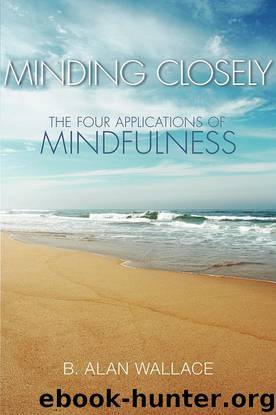Minding Closely: The Four Applications of Mindfulness by Wallace B. Alan

Author:Wallace, B. Alan [Wallace, B. Alan]
Language: eng
Format: azw3
Tags: four foundations of mindfulness
Publisher: Shambhala Publications
Published: 2011-07-16T03:00:00+00:00
7. Mindfulness of the Mind
THE THIRD of the four close applications of mindfulness concerns mental events and processes. Attending to mental phenomena is a subtle practice. Success in observing mental events as they occur is not achieved by trying harder but, counterintuitively, by relaxing more deeply while maintaining the luminosity of awareness.
NATURAL BALANCE
The practice I call balancing earth and wind was a mainstay in the Sha-matha Project retreats. The earth aspect entails full-body awareness—letting awareness permeate the entire field of tactile sensations, with special emphasis on the earth element, while attending to the sensations of the breath throughout the body. The wind aspect refers to the practice of settling the mind in its natural state, for in this practice we “face into the wind” of the ongoing flow of thoughts, images, and other mental events, like a falcon kiting into the wind.
These practices can be done in any posture, but the supine position is particularly good for evoking the earth element. Many people find that an upright position enhances clarity of attention. The best position depends on your tendency toward excitation or laxity. If your mind tends toward excitation, distraction, and restlessness, the supine position can be quite helpful. Excitation is overcome by the bodily feeling of profound melting in the corpse pose. A supine position promotes deep physical and mental relaxation, so often lacking in our hyperactive world. On the other hand, when the mind tends toward dullness, laxity, and lethargy, a vigilantly maintained seated posture offers the advantage of enhanced vividness and clarity of attention. Posture is of tremendous value in counteracting both mental excitation and laxity.
The following practice consists of two sessions, with a short break in between. The first session focuses on the earth element; a deep sense of relaxation results from full-body awareness in the supine position, ideal for attending to a large field of contact with the earth element. The second session focuses on the space of the mind and its contents, for which a seated position is optimal.
Download
This site does not store any files on its server. We only index and link to content provided by other sites. Please contact the content providers to delete copyright contents if any and email us, we'll remove relevant links or contents immediately.
The Way of Zen by Alan W. Watts(6512)
Ego Is the Enemy by Ryan Holiday(5297)
The Art of Happiness by The Dalai Lama(4064)
The Book of Joy by Dalai Lama(3904)
Why Buddhism is True by Robert Wright(3405)
Spark Joy by Marie Kondo(3252)
Shift into Freedom by Loch Kelly(3137)
Happiness by Matthieu Ricard(2996)
A Monk's Guide to a Clean House and Mind by Shoukei Matsumoto(2870)
The Lost Art of Good Conversation by Sakyong Mipham(2578)
The Meaning of the Library by unknow(2508)
The Unfettered Mind: Writings from a Zen Master to a Master Swordsman by Takuan Soho(2249)
The Third Eye by T. Lobsang Rampa(2226)
Anthology by T J(2162)
Red Shambhala by Andrei Znamenski(2154)
The Diamond Cutter by Geshe Michael Roach(2022)
Thoughts Without A Thinker: Psychotherapy from a Buddhist Perspective by Epstein Mark(1962)
Twilight of Idols and Anti-Christ by Friedrich Nietzsche(1851)
Advice Not Given by Mark Epstein(1839)
